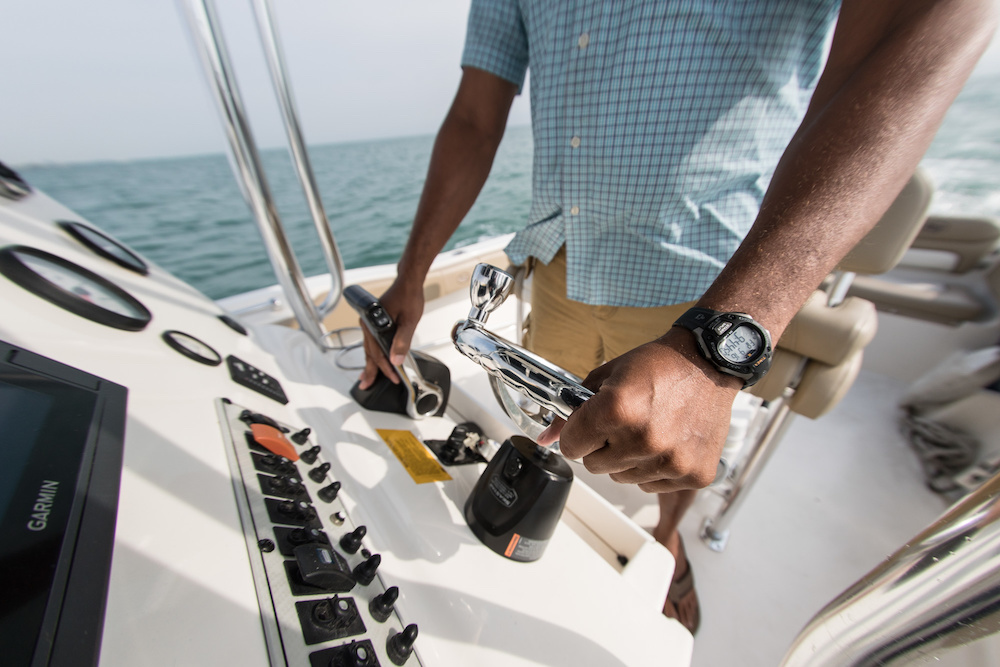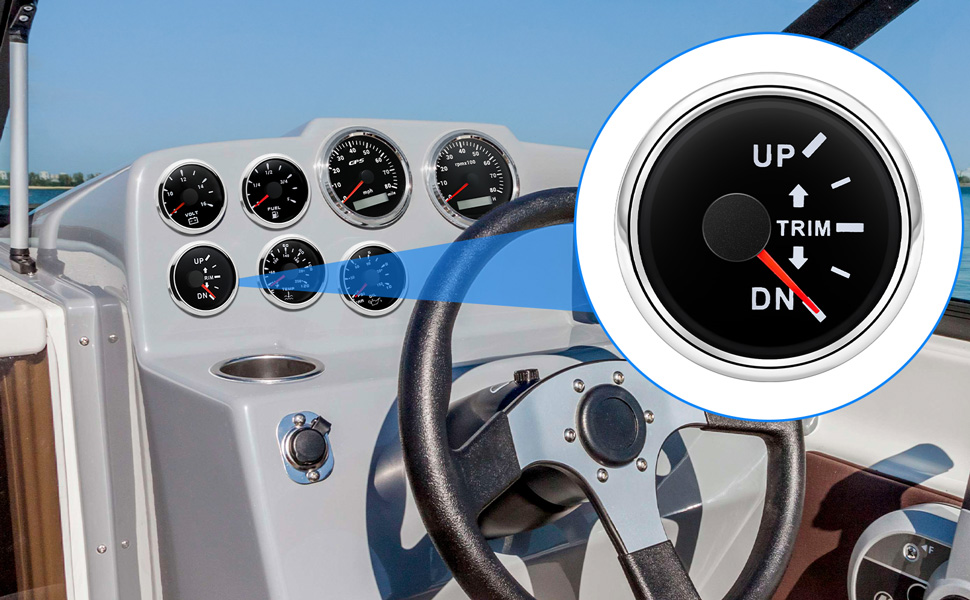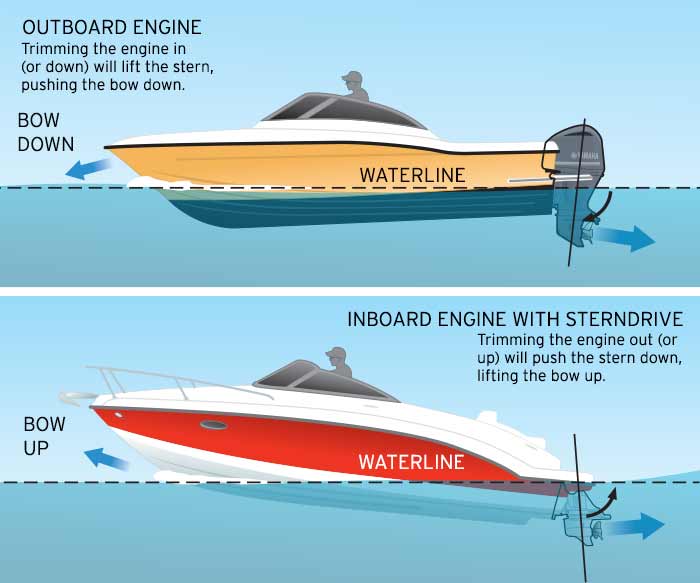How to Correctly Trim an Outboard Engine
Okay, so I’ve nailed my ports and my starboards and I know my bow from my stern. But I have a problem. I’ve discovered that my true kryptonite is outboard engine trim.
I don’t know how to trim an outboard motor, I don’t know what the ideal outboard motor trim position should look like and, if I’m honest, I’m not even sure what outboard trim is.
Well, this guide to outboard engine trim is designed to smooth out the bumps and teach you one of boating’s most valuable skills - one that, with a bit of practice, will help you operate your boat with far greater comfort and efficiency when you’re out on the water.
What is "trimming" your outboard motor?
The word ‘trimming’ is used to describe the action of adjusting the angle of the outboard motor on your transom. When you trim your engine, you fine-tune the angle of the propeller in the water and, assuming you’re underway, that change in the direction of thrust will change the running attitude of your boat relative to the surface.
When you start learning to trim the engine, it’s therefore important to understand the effect the angle of your propeller will have on your boat’s hull. We’ll discuss the physics of that in a moment but first, let’s examine the basics…

What is the "Trim Angle" of the Engine?
Trim angle of an outboard is the angle between the boat bottom and the propeller shaft formed by moving the engine/stem drive closer to the boat transom, called trimming "in" or "down" or "under," or moving the outboard further away from the boat transom called trimming "out" or "up."
When a boat is cruising on plane and the trim is adjusted so that the propeller shaft is parallel to the surface of the water, that is said to be running at "neutral" or "zero" trim. On outboards without power trim, this angle is adjusted by changing the hole in which the adjustable tilt pin is inserted.
The term "trim" is generally used when referring to adjusting the outboard within the first 20° range of travel. This is the range used while operating your boat on plane. The term "tilt" is generally used when referring to adjusting the outboard further up out of the water. The trim angle of the outboard has a distinct effect on the planing angle of the boat which, in turn, significantly alters top speed and handling.
The engine should be trimmed in for best start-up acceleration and shortest time to plane. The engine would then be trimmed out for peak performance. If trimmed "in" (under) too far the bow drops and the boat runs too wet. In this condition, top speed drops, fuel economy decreases, the boat may oversteer in one direction or the other ("bow steering"), and steering torque will increase (to the right with a right-hand rotation propeller). Occasionally, extreme trim under can cause a boat to list to the left (with a right-hand propeller).
How do you "trim" an outboard motor?
On most outboard rigs, there are two places you can adjust the trim. First, there’s a button located on the throttle lever, perfectly positioned so you can adjust the trim up and down with your thumb or index finger, depending on the orientation of the control box.
This is the primary button and it’s specifically designed so you can operate it without having to change your grip on the throttle. The second rocker switch is located on the side of the engine itself. This obviously requires you to be at the back of the boat in order to operate it and it only tends to be used when the boat is stationary.
The trim of the engine, or its position in the arc between fully down and fully up, is usually measured and displayed by means of a dial on the dash. This stops you from having to look over your shoulder to visually check the engine’s angle. A boat's hull will be affected by the angle of the propeller in the water.

What are the impacts of outboard motor trim position?
When we trim up, we tilt the engine upwards, swinging the propeller away from the boat. As the propeller spins, it then creates a downward force on the rear end of the boat, thereby lifting the boat’s nose higher out of the water. When you trim down, the opposite occurs.
The prop is buried deeper beneath the boat and the change in the angle of thrust pushes the stern up and forces the bow down.

What are the benefits of the perfect outboard motor trim position?
01. It will improve your fuel economy.
02. It will reduce the load on your engine.
03. It will improve ride comfort.
04. It will improve handling.
05. It will preserve the health of your propeller.
06. It will minimize the likelihood of accidents.
07. It will enable you to explore the full potential of your boat’s performance.
What does this mean as we travel through the water?
Imagine for a moment that our body of water is calm and we are traveling at a steady cruising speed. If you trim up, lift the engine and elevate the bow, there is less forward hull in the water. As you travel, the mid-section of the boat’s hull now becomes the first point of contact.
Trimming up can help you run fast on the flat or, in the following sea, it can help you prevent the nose from ‘stuffing’ into a wave. But if you trim up too much, the boat can become unstable and uncomfortable as, rather than carve through the water, it skates around with reduced steering capacity and with a bow that lifts and drops in a phenomenon known as ‘porpoising’.
Conversely, if you trim down, thereby lowering the bow, the front of the hull becomes the first point of contact with the water, providing greater control and directional stability. This can be useful in helping you run flat when a head sea is trying to lift your bow. But if you trim too low, you encounter what is known as ‘ploughing’ – digging the hull in deep, increasing resistance, causing drag, burning unnecessary fuel, reducing speed, compromising the ride quality and overworking your engine.
How do I find the outboard trim ‘sweet spot’?
The more you get to know your own boat, the easier it will become to find the perfect sweet spot. But of course, this will tend to change according to your speed, the sea conditions, your weight distribution and your angle in relation to the prevailing swells. Because of these dynamic variables, you will generally have to make small adjustments throughout any journey to maintain your optimum running attitude.

But what you generally want to see once you’re on the plane is the boat hull roughly level, the ride relatively stable and the wake emerging from a point on the side of the boat that is around about two thirds back from the bow. Once you’re in this position, try trimming down.
You will feel increased resistance, as the revs drop, the speed decreases by a couple of knots and the wake moves forward. If it’s safe to do so, you can also try shifting the trim back up beyond the sweet spot. Feel how the bow lifts, the revs rise and the boat becomes less stable.
Several things may happen here.
While a spot of porpoising is a useful indicator that you’re overdoing it, you may also begin to experience ventilation. This is where the propeller comes too close to the surface, drawing air into the mix and causing your boat to over-rev, lose thrust and slow down.
You may also encounter a ‘chine walk’. This is where lateral stability becomes compromised and the boat begins to rock from side to side. This can get worse and become dangerous if nothing is done to arrest it, so you need to regain control by easing back the throttle and trimming back down until the boat regains its composure and efficiency.
Where do I find parts for my tilt and trim?
As a boat owner, you know (or will come to know) that eventually you will need parts for your outboard tilt and trim. All major brands of outboards use their own design of tilt and trims. Marine Parts Warehouse carries complete replacement tilt and trims and repair parts.
Posted by Art Vandelay


